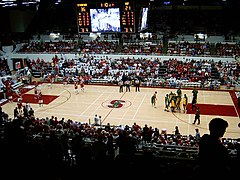This article needs additional citations for
verification. (August 2017) |
 | |
| Full name | Roscoe Maples Pavilion |
|---|---|
| Location | 655 Campus Drive Stanford, California |
| Coordinates | 37°25′47″N 122°09′38″W / 37.4296°N 122.1605°W |
| Owner | Stanford University |
| Operator | Stanford University |
| Capacity | Basketball: 7,233 |
| Construction | |
| Broke ground | 1967 |
| Opened | January 3, 1969 55 years ago |
| Renovated | March 2004 |
| Construction cost |
$3.24 Million ($26.9 million in 2023 dollars [1]) |
| Architect | John Carl Warnecke |
| Tenants | |
| Stanford Cardinal (1969–present) | |
Maples Pavilion is a 7,392-seat multi-purpose arena on the campus of Stanford University in Stanford, California. Opened in 1969, Maples underwent a $30 million renovation in March 2004 and reopened ahead of schedule, in time for conference play that December. [2] [3] [4] It was named after its principal donor, Roscoe Maples. [5]
History
Roscoe Maples was an Oregon lumber magnate. Upon his death in 1963, Maples bequeathed most of his $2 million estate to the university. A member of the class of 1904, he left school before graduating to support his parents, and later went on to success in the lumber business. [5] Prior to 1969, Stanford played at the Old Pavilion, opened in 1922.
Maples is home to multiple Stanford Cardinal athletics teams, including men's and women's basketball, men's and women's gymnastics, and women's volleyball. The raucous student section that roots for the men's basketball team is called the "6th Man" and is located in several rows courtside. [6]
Prior to the renovation, the original floor at Maples had a flexible surface. [3] Designed by Stanford graduate John Carl Warnecke (1919–2010), it was installed when the Pavilion opened in 1969. Nine inches (23 cm) of crosshatched wood and air was supposed to create a coil-spring effect preventing injuries, but often had the opposite effect. [4] [7] It caused a "Missed Stair Effect", a phenomenon that occurs when the body senses where the floor should be upon landing after a jump. With the tensile feeling of the floor, often the level would be different from when the player jumped, causing a strange sensation throughout the body.
On October 14, 2010, the Dalai Lama advocated a secular approach to compassion to a standing-room-only crowd.
See also
References
- ^ 1634–1699: McCusker, J. J. (1997). How Much Is That in Real Money? A Historical Price Index for Use as a Deflator of Money Values in the Economy of the United States: Addenda et Corrigenda (PDF). American Antiquarian Society. 1700–1799: McCusker, J. J. (1992). How Much Is That in Real Money? A Historical Price Index for Use as a Deflator of Money Values in the Economy of the United States (PDF). American Antiquarian Society. 1800–present: Federal Reserve Bank of Minneapolis. "Consumer Price Index (estimate) 1800–". Retrieved February 29, 2024.
- ^ "Maples Pavilion remodel on schedule". Spokesman-Review. Spokane, Washington. Associated Press. August 20, 2004. p. C7.
- ^ a b "Stanford missing familiar Maples' floor". Lodi News-Sentinel. California. Associated Press. December 27, 2004. p. 16.
- ^ a b Moseley, Rob (January 25, 2005). "Brand new floor plan". Eugene Register-Guard. Oregon. p. E1.
- ^ a b Thacher, Steve (February 13, 1969). "New pavilion to be dedicated". Stanford Daily. California. p. 3.
- ^ Bosley, Don (January 29, 1998). "Stanford sixth-man keeps it fun around Maples Pavilion". Moscow-Pullman Daily News. Idaho, Washington. (Sacramento Bee). p. 1D.
- ^ Mague, Anthony (February 11, 2004). "Stanford's injury-causing, springy floor to be removed". Daily Orange. Syracuse, New York. Retrieved August 3, 2015.
External links
- Stanford Cardinal basketball
- Stanford Cardinal gymnastics
- Stanford Cardinal volleyball
- Stanford University buildings and structures
- College basketball venues in the United States
- Indoor arenas in California
- Sports venues in the San Francisco Bay Area
- Sports venues in Santa Clara County, California
- 1969 establishments in California
- Sports venues completed in 1969
- College volleyball venues in the United States
- Basketball venues in California
- Gymnastics venues in California
- Volleyball venues in California
- California sports venue stubs
- Santa Clara County, California building and structure stubs

